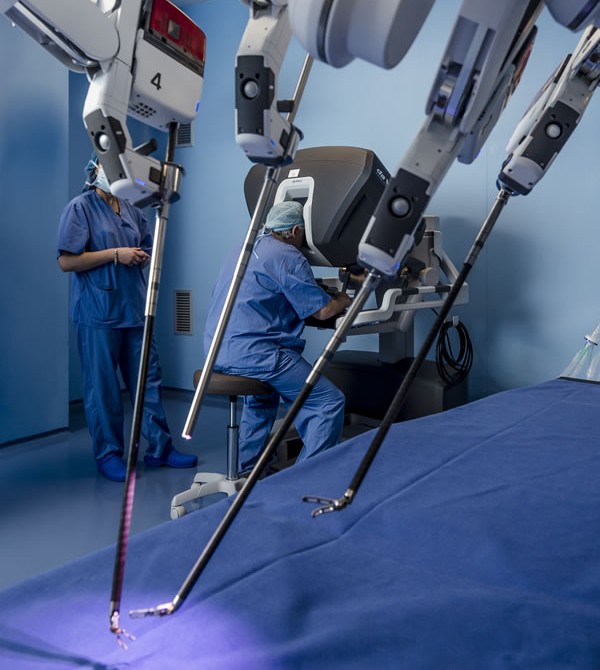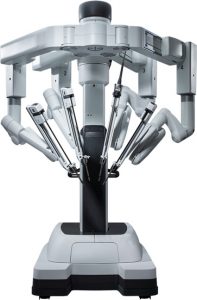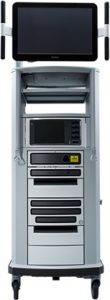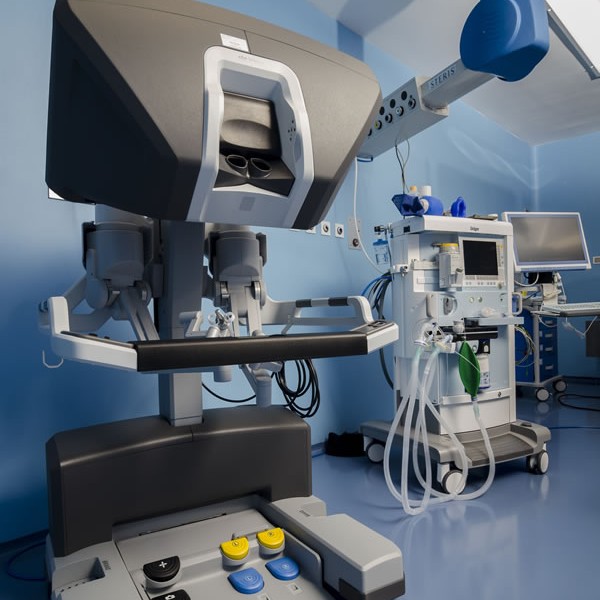
What is da Vinci robotic system?
The robotic system da Vinci is nowadays the only technology available to access a real robotic surgery. It offers equal and better results than conventional surgery, with the benefits of minimally invasive surgery.

Robotic surgery is the las development of minimally invasive surgery, subsequent to laparoscopy, in wich the surgeon doesn’t perform it with his hands, but using a remote robot, sitting on a console settled in the OR. The computerized system turns the hand’s movement in pulses that are channeled to the robotic arms.
IMED Hospitals begun the Robotic Surgery Programme with the incorporation of a da Vinci Xi-HD surgical robot installed in the IMED Valencia hospital.
The objective of this action is to offer all patients this last generation technology for the indications established, and be on the cutting edge of surgical treatment, (being nowadays the only robot with these features available in the Valencian Community).
How does da Vinci XI system work?
The da Vinci XI robot is, among da Vinci systems, the most developed da Vinci platform, as the most advanced system for minimally invasive robotic surgery.
Development based on the concept “Immersive Intuitive Interface”, it is the only robotic system that:
- Translate in an intuitive way the surgeon’s movements, so there is full control of the optical fiber and tools, avoiding difficult laparoscopic movements.
- It provides a three-dimensional real view of the operative domain: the surgeon literally enters in a “immersion” process, without glasses or any other equipment help, with the objective of value the best as possible the anatomic dissection levels and “live” the surgical intervention nearly from the inside of patient’s body.

Moreover, da vinci xi robotic system:
- Allows a 3D vision with an increase up to 10 times, guarantying clarity and accuracy of the details considerably superior to the laparoscopic technique
- It eliminates hand’s physiologic shaking of the surgeon or not volunteer movements;
- It has four robotic arms, exchangeable, assembled in just one pillar;
- It matches with other technology normally present in worldwide OR;
- It has a positioning laser system that make possible to optimize the arms positioning depending on the intervention selected and the trocars positioning, to reduce preparation and operation time;
- It uses tools with 8 mm diameter till a maximum of 12mm, called Endowrist, because it provides free movement in 7 axes (unlike the 4 grades of the tools of conventional laparoscopy) and a rotation of almost 360º;
- It allows a multiquadrant surgery, in other words, to perform more difficult interventions acting on the organs that are settled in different anatomic quadrants, with no need of patient’s forecast or robot positioning changes.
SURGICAL CONSOLE
It is the control core. Through the console, the surgeon can control the optical fiber and the tools through two manipulatos and pedals.

PATIENT’S CART
It is the operative part of the da vinci system and it is formed by four mobile and interchangeable arms, intended to support the optical fiber, and tools of 5mm till 8mm maximum.

VIEWING TOWER
It has the main unit of imaging elaboration.

Which are the advantages of the robotic surgery da Vinci?
The robotic system da Vinci offers many advantages in open surgery, the most advanced tele-assited laparoscopy, for professionals and patients.

Main clinical advantages:
- Radically oncology, in other words, removal.
- Easy access to complicated anatomies.
- Excellent visualization of anatomical landmarks.
- More detailed visualization of the slit planes.
- More detailed on the demolitive procedure.
- More reconstruction accuracy.
- Possibility of configuration of surgical movement accuracy (possible scales 1,5:1,2:1,3:1).
- Physiological shaking elimination.
- Less operation time compared to laparoscopy.
Advantages for the patient:
- Small incisions with better aesthetic results.
- Less transfusion need.
- Less postoperative pain.
- Hospitalization time reduction, that in lots of cases is reduce even half of it.
- More fast recover to normal activities.





